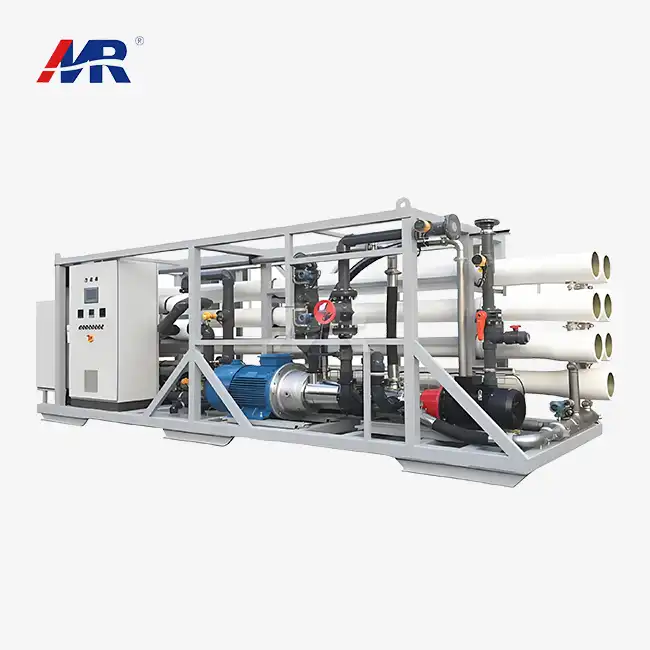How Do ERDs Reduce SWRO Operating Costs by 40%?
Energy Recovery Devices are game-changers in the realm of seawater desalination, offering substantial cost savings and improved operational efficiency. By harnessing the high-pressure energy from the concentrated brine stream, ERDs significantly reduce the energy required to pressurize incoming seawater. This innovative approach leads to a remarkable reduction in operating costs, often reaching up to 40% in SWRO plants.
The Economics of Energy Recovery
The cost-saving potential of ERDs stems from their ability to recycle energy that would otherwise be wasted. In a typical SWRO process, high-pressure pumps force seawater through semi-permeable membranes, separating fresh water from salt. Traditionally, the remaining high-pressure brine was simply discharged, wasting valuable energy. ERDs capture this energy and transfer it back into the system, dramatically reducing the power required for the high-pressure pumps.
Quantifying the Savings
To put the 40% cost reduction into perspective, consider a medium-sized seawater desalination plant producing 50,000 cubic meters of fresh water per day. Without ERDs, such a plant might consume around 4-5 kWh of energy per cubic meter of water produced. With advanced ERDs, this can be reduced to approximately 2.5-3 kWh per cubic meter. Over a year, this translates to millions of kilowatt-hours saved, resulting in substantial financial benefits and reduced carbon footprint.
Pressure Exchanger Technology: How It Works
Pressure exchanger technology represents a significant leap forward in ERD design, offering unparalleled efficiency in energy recovery for SWRO systems. These devices operate on a simple yet ingenious principle: direct pressure exchange between the high-pressure brine and the incoming seawater.
The Mechanics of Pressure Exchange
At the heart of a pressure exchanger is a rotor with several ducts. As the rotor spins, these ducts are alternately exposed to high-pressure brine and low-pressure seawater. The high-pressure brine enters the ducts, transferring its pressure energy directly to the incoming seawater. This pressurized seawater is then fed into the RO membranes, significantly reducing the workload on the high-pressure pumps.
Advantages of Pressure Exchanger ERDs
Pressure exchangers offer several advantages over other ERD types:
- High efficiency: They can recover up to 98% of the available energy from the brine stream.
- Low maintenance: With only one moving part, they require minimal upkeep.
- Durability: Constructed from corrosion-resistant ceramics, they have a long operational life.
- Scalability: They can be easily scaled to suit various plant sizes.
These features make pressure exchangers particularly attractive for large-scale seawater desalination systems, where energy efficiency is paramount.
Energy Recovery Efficiency: Comparing Leading ERD Models
While pressure exchangers have set new standards in energy recovery efficiency, it's important to consider other ERD models and their relative performance. This comparison helps plant designers and operators make informed decisions based on their specific requirements and operational conditions.
Turbochargers
Turbochargers, an older ERD technology, use the energy from the brine stream to drive a turbine, which in turn powers a pump to pressurize incoming seawater. While less efficient than pressure exchangers, typically recovering 70-80% of available energy, they remain a viable option for some applications due to their simplicity and lower initial cost.
Hydraulic Turbochargers
These devices combine the functions of a turbine and a pump in a single unit. They offer improved efficiency over standard turbochargers, with energy recovery rates of 80-85%. Hydraulic turbochargers are particularly suitable for medium-sized SWRO plants where their balance of efficiency and cost-effectiveness is advantageous.
Work Exchangers
Work exchangers, also known as piston-type ERDs, use a piston to transfer pressure from the brine to the feed water. They can achieve energy recovery efficiencies of up to 95%, approaching the performance of pressure exchangers. However, they are more complex and may require more maintenance than other ERD types.
Comparative Analysis
When comparing ERD models, several factors come into play:
- Energy recovery efficiency
- Initial investment cost
- Maintenance requirements
- Operational flexibility
- Plant size and capacity
For large-scale SWRO plants, pressure exchangers often emerge as the preferred choice due to their superior efficiency and low maintenance needs. However, for smaller plants or those with specific operational constraints, other ERD types may prove more suitable.
Future Trends in ERD Technology
The field of ERD technology continues to evolve, with ongoing research focusing on further improving efficiency and reducing costs. Emerging trends include:
- Integration of ERDs with advanced control systems for optimized performance
- Development of hybrid ERD systems combining multiple technologies
- Use of advanced materials to enhance durability and efficiency
- Miniaturization of ERDs for small-scale and portable desalination units
These advancements promise to make seawater desalination plants even more energy-efficient and cost-effective in the future, potentially revolutionizing water supply solutions for coastal regions worldwide.
Conclusion
Energy Recovery Devices have transformed the landscape of seawater desalination, making it a more viable and sustainable solution for addressing water scarcity. By significantly reducing energy consumption and operational costs, ERDs have played a crucial role in the widespread adoption of SWRO technology. As the global demand for fresh water continues to rise, the ongoing development and refinement of ERD technologies will be instrumental in ensuring the efficiency and sustainability of seawater desalination processes.
Are you looking to optimize your seawater desalination operations or implement a new SWRO system? Guangdong Morui Environmental Technology Co., Ltd. is your trusted partner in water treatment solutions. We offer cutting-edge seawater desalination plants designed to meet the diverse needs of industries ranging from water treatment to manufacturing. Our state-of-the-art RO systems, coupled with advanced ERD technology, ensure maximum efficiency and cost-effectiveness for your desalination needs.
Don't let water scarcity limit your operations. Contact us today at benson@guangdongmorui.com to discover how our innovative solutions can transform your water purification processes and drive your business forward. Let Guangdong Morui be your guide to a sustainable water future!
References
1. Elimelech, M., & Phillip, W. A. (2011). The future of seawater desalination: Energy, technology, and the environment. Science, 333(6043), 712-717.
2. Straub, A. P., Deshmukh, A., & Elimelech, M. (2016). Pressure-retarded osmosis for power generation from salinity gradients: Is it viable? Energy & Environmental Science, 9(1), 31-48.
3. Zarzo, D., & Prats, D. (2018). Desalination and energy consumption. What can we expect in the near future? Desalination, 427, 1-9.
4. Gude, V. G. (2016). Desalination and sustainability – An appraisal and current perspective. Water Research, 89, 87-106.
5. Ghaffour, N., Missimer, T. M., & Amy, G. L. (2013). Technical review and evaluation of the economics of water desalination: Current and future challenges for better water supply sustainability. Desalination, 309, 197-207.
6. Kurihara, M., & Hanakawa, M. (2013). Mega-ton Water System: Japanese national research and development project on seawater desalination and wastewater reclamation. Desalination, 308, 131-137.

_1745823981883.webp)


